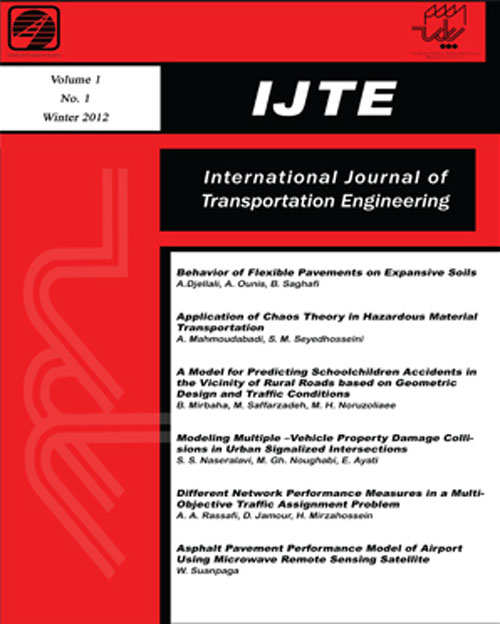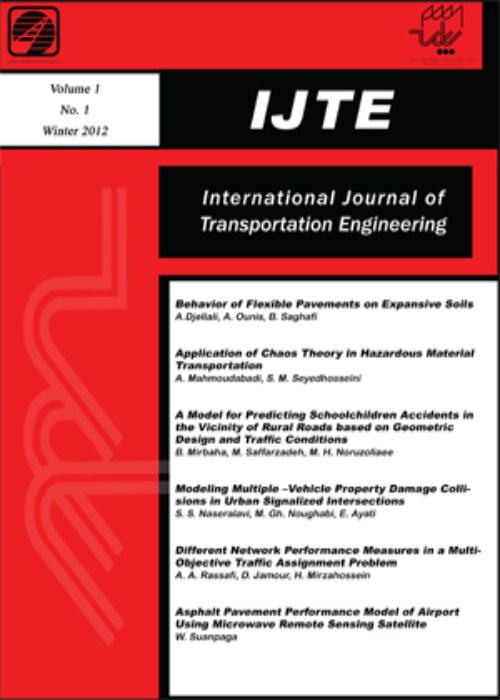فهرست مطالب

International Journal of Transportation Engineering
Volume:4 Issue: 3, Winter 2017
- تاریخ انتشار: 1395/10/28
- تعداد عناوین: 6
-
-
Pages 147-161Guiding vehicles to their destination under dynamic traffic conditions is an important topic in the field of Intelligent Transportation Systems (ITS). Nowadays, many complex systems can be controlled by using multi agent systems. Adaptation with the current condition is an important feature of the agents. In this research, formulation of dynamic guidance for vehicles has been investigated based on the characteristics of ITS and using the user-based approach to meet drivers satisfaction. As a result of time-varying flows on traffic networks, a multi agent model and the routing algorithm based on artificial intelligence techniques emphasized on a hybrid algorithm combining Ant Colony and Reinforcement Learning is proposed. The critical result of this paper is the ability of designing an algorithm for better trip planning, routing decisions in a dynamic urban transportation. Finally, the validity of the proposed algorithm is shown by implementation on a sub-network extracted from Tehran traffic map.Keywords: urban transportation network, route guidance, ANT-Q algorithm, Intelligent Agents, user-based system
-
Pages 163-177This study investigates propagation of mode I crack in B70 pre-stressed concrete sleepers by fracture mechanics approach. A new experimental analysis is done for notched B70 pre-stressed concrete sleepers with Replica test and image analysis. A scanning electron microscope test (SEM) and an image analysis are applied for the Replica test in order to determine crack length and crack mouth opening displacement (CMOD). The experimental data extracted from the three-point bending load test of B70 sleepers are analyzed with fracture mechanics method. In this study, the fracture mechanics parameters of a sleeper are investigated based on nonlinear fracture mechanics (NLFM) principles for concrete material. Sleepers with initial crack width of 8 mm and different initial crack lengths of 5 mm to 45 mm, with a 10 mm increasing step, are tested. Five specimens of each group are loaded under three-point bending load test, in order to determine the propagated crack length, crack mouth opening displacement (CMOD), final load and the specimens energy. The results showed that by increasing the crack-to-depth ratio, both final load and specimens energy values are decreased linearly. Also, these analyses confirm that the structural behavior of the pre-stressed concrete sleepers can be predicted by a simple fracture mechanics test, such as beams in bending, provided that the related structural conditions like initial crack length and CMOD, are known.Keywords: Fracture mechanics, Crack propagation, Pre-stressed concrete sleeper B70, Crack length, CMOD
-
Pages 179-196
Establishing a network of transit routes with satisfactory demand coverage is one of the main goals of transit agencies in moving towards a sustainable urban development. A primary concern in obtaining such a network is reducing operational costs. This paper deals with the problem of minimizing construction costs in a grid transportation network while satisfying a certain level of demand coverage. An algorithm is proposed following the general idea of constructive algorithms in related literature. The proposed algorithm, in an iterative approach, selects an origin-destination with maximum demand, generates a basic shortest-path route, and attempts to improve it through a route expansion process. The paper reports the scenarios and further details of the algorithm considered for expanding a transit route in a grid network. A random 6×10 grid network is applied to report the results. The results support that application of the proposed algorithm notably reduces the operational costs for various amounts of demand coverage.
Keywords: Transit routes, grid transportation network, demand coverage, operational costs -
Pages 197-210The aim of this study is to propose a comprehensive approach for handling the crew scheduling problem in the railway systems. In this approach, the information of different railway trips are considered as input and the problem is divided to three separated phases. In phase I, we generate all feasible sequences of the trips, which are named as the pairings. A depth-first search algorithm is developed to implement this phase. In phase II, the pairings constituting the optimal solution are to be obtained. Both mentioned phases are handled in a centralized decision-making system for the entire railway network. Phase III aims to locally assign the crew groups to the optimal pairings. To solve the problem in phase III, a new mathematical model is developed in this paper. The model can determine the minimum required crew groups, and optimally assign the crew groups to the selected pairings of each home depot. In order to evaluate the developed algorithm and model, the Iranian railway network is evaluated by consideration of all passenger trips of the network. The results show that the proposed approach is capable of efficiently generating the optimal schedules for the railway crew groups in a reasonable computation time.Keywords: Railway, crew scheduling, trip, pairing, optimal solution
-
The Effects of Concrete Pavement Mix Design Parameters on Durability under Freeze and Thaw ConditionPages 211-224This paper is based on an experimental research that examined the effects of concrete`s major parameters on durability of concrete pavements and curbs under freezing and thawing cycles. These parameters include concrete mix design parameters such as water-cement ratio, fine aggregate percentage and using air entraining admixture and simulating real freeze-thaw cycles that infrastructures undergo by considering deicing salt and water flow. Four types of concrete samples were prepared and submerged in four different freeze-thaw conditions. Their weight and compressive strength were measured and the results were analyzed. Based on the results, regression analysis was used and two linear models were developed to predict the weight loss and compressive strength loss of concrete under freeze-thaw cycles. The results indicated that fine aggregate percentage is a key factor in durability of concrete, and concrete samples with 6% air underwent less deterioration in comparison to concrete with lower water-cement ratio. In addition, water flow increases the deterioration of concrete under freeze-thaw cycles specially when deicing salt is present.Keywords: Concrete pavements, Freeze, thaw cycles, Water, cement ratio, Fine aggregate percentage. Air entraining admixture
-
Pages 225-254The blood supply chain as a part of healthcare systems play a substantial role in health improvement within societies, and blood supply for daily needs and especially in disasters is the challenges requiring more attention. This paper presents a fuzzy-stochastic mixed integer linear programming model to design blood supply chain network for disaster relief. To deal with the uncertainty in model parameters, a fuzzy programming approach is considered, and the combination of the expected value and the chance constrained programming is applied to solve the proposed model. Besides, a real case study in Iran is implemented to illustrate the applicability of the present model. The results implies that an appropriate adjustment in the capacity and coverage radius of blood facilities, the decrease in the disruption probability of facilities and transportation routes as well as referral rate can be applied as strategies to improve the supply chain costs. supply chain costs.Keywords: Blood supply chain, Disaster, Fuzzy credibility, Chance, constrained programming


